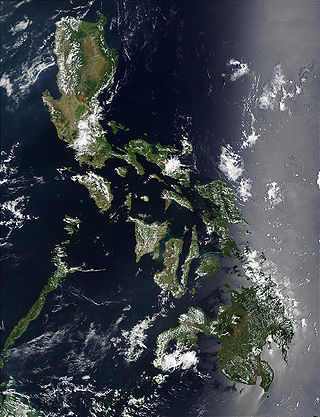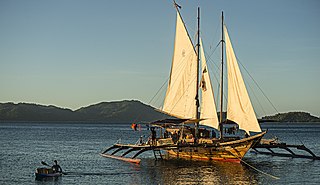Related Research Articles

Abu Sayyaf, officially known by the Islamic State as the Islamic State – East Asia Province, is a Jihadist militant and pirate group that followed the Wahhabi doctrine of Sunni Islam. It was based in and around Jolo and Basilan islands in the southwestern part of the Philippines, where for more than five decades, Moro groups had been engaged in an insurgency seeking to make Moro Province independent. The group was considered violent and was responsible for the Philippines' worst terrorist attack, the bombing of MV Superferry 14 in 2004, which killed 116 people. The name of the group was derived from Arabic abu, and sayyaf. As of April 2023, the group was estimated to have about 20 members, down from 1,250 in 2000. They used mostly improvised explosive devices, mortars and automatic rifles.

Mindanao is the second-largest island in the Philippines, after Luzon, and seventh-most populous island in the world. Located in the southern region of the archipelago, the island is part of an island group of the same name that also includes its adjacent islands, notably the Sulu Archipelago. According to the 2020 census, Mindanao has a population of 26,252,442 people, while the entire island group has an estimated population of 27,021,036 according to the 2021 census.

The Philippines is an archipelago that comprises 7,641 islands, and with a total land area of 300,000 square kilometers (115,831 sq mi), it is the world's fifth largest island country. The eleven largest islands contain 95% of the total land area. The largest of these islands is Luzon at about 105,000 square kilometers (40,541 sq mi). The next largest island is Mindanao at about 95,000 square kilometers (36,680 sq mi). The archipelago is around 800 kilometers (500 mi) from the Asian mainland and is located between Taiwan and Borneo.

Transportation in the Philippines covers the transportation methods within this archipelagic nation of over 7,500 islands. From a previously underdeveloped state of transportation, the government of the Philippines has been improving transportation through various direct infrastructure projects, and these include an increase in air, sea, road, and rail transportation and transport hubs.

Zamboanga del Sur, officially the Province of Zamboanga del Sur, is a province in the Philippines located in the Zamboanga Peninsula region in Mindanao. Its capital is the city of Pagadian. Statistically grouped with Zamboanga del Sur is the highly urbanized City of Zamboanga, which is geographically separated and a chartered city and governed independently from the province.

Sulu, officially the Province of Sulu, is a province of the Philippines in the Sulu Archipelago and part of the Bangsamoro Autonomous Region in Muslim Mindanao (BARMM).

Operation Enduring Freedom – Philippines (OEF-P) or Operation Freedom Eagle was part of Operation Enduring Freedom and the global War on Terror. The Operation targeted the various Jihadist terror groups operating in the country. By 2009, about 600 U.S. military personnel were advising and assisting the Armed Forces of the Philippines (AFP) in the Southern Philippines. In addition, by 2014, the CIA had sent its elite paramilitary officers from their Special Activities Division to hunt down and kill or capture key terrorist leaders. This group had the most success in combating and capturing Al-Qaeda leaders and the leaders of associated groups like Abu Sayyaf.

The vinta is a traditional outrigger boat from the Philippine island of Mindanao. The boats are made by Sama-Bajau, Tausug and Yakan peoples living in the Sulu Archipelago, Zamboanga peninsula, and southern Mindanao. Vinta are characterized by their colorful rectangular lug sails (bukay) and bifurcated prows and sterns, which resemble the gaping mouth of a crocodile. Vinta are used as fishing vessels, cargo ships, and houseboats. Smaller undecorated versions of the vinta used for fishing are known as tondaan.

BRP General Mariano Alvarez (PS-38) is the lead ship of its class of three coastal patrol ships currently in service with the Philippine Navy. She was the lead ship of the US Navy's Cyclone-class patrol ship prior to being transferred to the Philippine Navy.

A balangay, or barangay, is a type of lashed-lug boat built by joining planks edge-to-edge using pins, dowels, and fiber lashings. They are found throughout the Philippines and were used largely as trading ships up until the colonial era. The oldest known balangay are the Butuan boats, which have been carbon-dated to 320 AD and were recovered from several sites in Butuan, Agusan del Norte.

Zamboanga City, officially the City of Zamboanga, is a 1st class highly urbanized city in the Zamboanga Peninsula region of the Philippines. According to the 2020 census, it has a population of 977,234 people. It is the fifth-most populous and third-largest city by land area in the Philippines and also the second most populous in Mindanao after Davao City. It is the commercial and industrial center of the Zamboanga Peninsula Region.

Commodore Ramon Abacan Alcaraz was a Filipino World War II hero, Naval officer, and businessman best known as a recipient of the Silver Star for heroism and gallantry as part of the Offshore Patrol unit of the U.S. Army Forces in the Far East (USAFFE) during the Second World War; and as one of the earliest critics of the Marcos dictatorship within the Armed Forces of the Philippines.

Bilateral relations between China and the Philippines had significantly progressed since the 1990s, peaking during the Philippine presidencies of Gloria Macapagal Arroyo and Rodrigo Duterte. However, relations have become very tense due to territorial disputes in the South China Sea, particularly since the 2012 Scarborough Shoal standoff; in 2013, the Philippine government under President Benigno Aquino III in 2013 filed an arbitration case at The Hague against China over China's expansive maritime claims. The policy of current Philippine president Bongbong Marcos aims for distancing relations between the Philippines and China in favor of the country's relationship with the United States. The current policy of the general secretary of the Chinese Communist Party aims for greater influence over the Philippines, and the region in general, while combating American influence.

The Zamboanga City crisis or Zamboanga Siege was an armed conflict in Zamboanga City, Philippines between the government forces of the Philippines and Moro rebels from the Moro National Liberation Front (MNLF) that began on September 9, 2013 and ended twenty days later on September 28. The conflict began when MNLF rebels, under the command of Nur Misuari, attempted to occupy several coastal communities in Zamboanga City in protest of the Philippine government's failure to implement the 1996 final peace agreement with the MNLF.

The Multi-Purpose Assault Craft (MPAC) is a type of fast attack assault craft developed for the Philippine Navy. Originally designed to transport troops at a high speed and then land them on the beach, they have since expanded their roles to include interdiction, surface warfare, and search and rescue.
BRP Cape San Agustin (MRRV-4408) is the seventh ship of the Parola-class patrol vessels of the Philippine Coast Guard.

BRP Bagacay (MRRV-4410) is the ninth ship of the Parola-class patrol vessels of the Philippine Coast Guard.

Bangka are various native watercraft of the Philippines. It originally referred to small double-outrigger dugout canoes used in rivers and shallow coastal waters, but since the 18th century, it has expanded to include larger lashed-lug ships, with or without outriggers. Though the term used is the same throughout the Philippines, "bangka" can refer to a very diverse range of boats specific to different regions. Bangka was also spelled as banca, panca, or panga in Spanish. It is also known archaically as sakayan.
Tempel, also known as temper or kurikong, is a type of wooden motorized boat used by the Yakan, Tausug, and Sama-Bajau people of the Philippines. It is commonly used in the Sulu Archipelago and the Zamboanga Peninsula. It is around 48 ft (15 m) long, 11 ft (3.4 m) deep, and around 5 ft (1.5 m) at the widest point. It has a V-shaped cross-section at the front, though it is flat-bottomed on the stern for stability. It is commonly made from thick marine lauan plywood attached to ribs and caulked with epoxy. Tempel can also be made from fiberglass, though wood is preferred. Tempel are larger than the junkung but smaller than the kumpit. They are usually used as cargo ships.

Toribio Dulinayan Adaci Jr. is a Philippine Navy vice admiral who serves as the 40th and current Flag Officer-in-Command (FOIC) of the Philippine Navy. Prior to his appointment, Adaci previously commanded the Naval Forces Western Mindanao from 2020 to 2022, the Naval Installation Command, and Fleet-Marine Ready Force.
References
- ↑ "Sea bandits kill 8 fishing boat crewmen off Zamboanga City". Update Philippines. 10 January 2017. Retrieved 13 January 2020.
- ↑ de Guzman, Robert (2 October 2019). "P2.4M worth of smuggled cigarettes seized in Zamboanga". UNTV News & Rescue. Retrieved 13 January 2020.
- ↑ Alipala, Julie (26 June 2019). "Navy intercepts smuggled cigarettes in Zamboanga". Philippine Daily Inquirer. Retrieved 13 January 2020.
- ↑ Garcia, Bong (27 September 2013). "MNLF-occupied island falls to gov't troops". SunStar Philippines. Retrieved 13 January 2020.
- ↑ Banagudos, Rey-Luis (26 December 2018). "Wooden boatmaking embraces Mindanao life, culture". Philippine News Agency. Retrieved 11 January 2020.
- ↑ Amata, Noel R. "THE GREAT SANTA CRUZ ISLAND, Zamboanga City". My Travel Photos and Stories. Retrieved 13 January 2020.




